



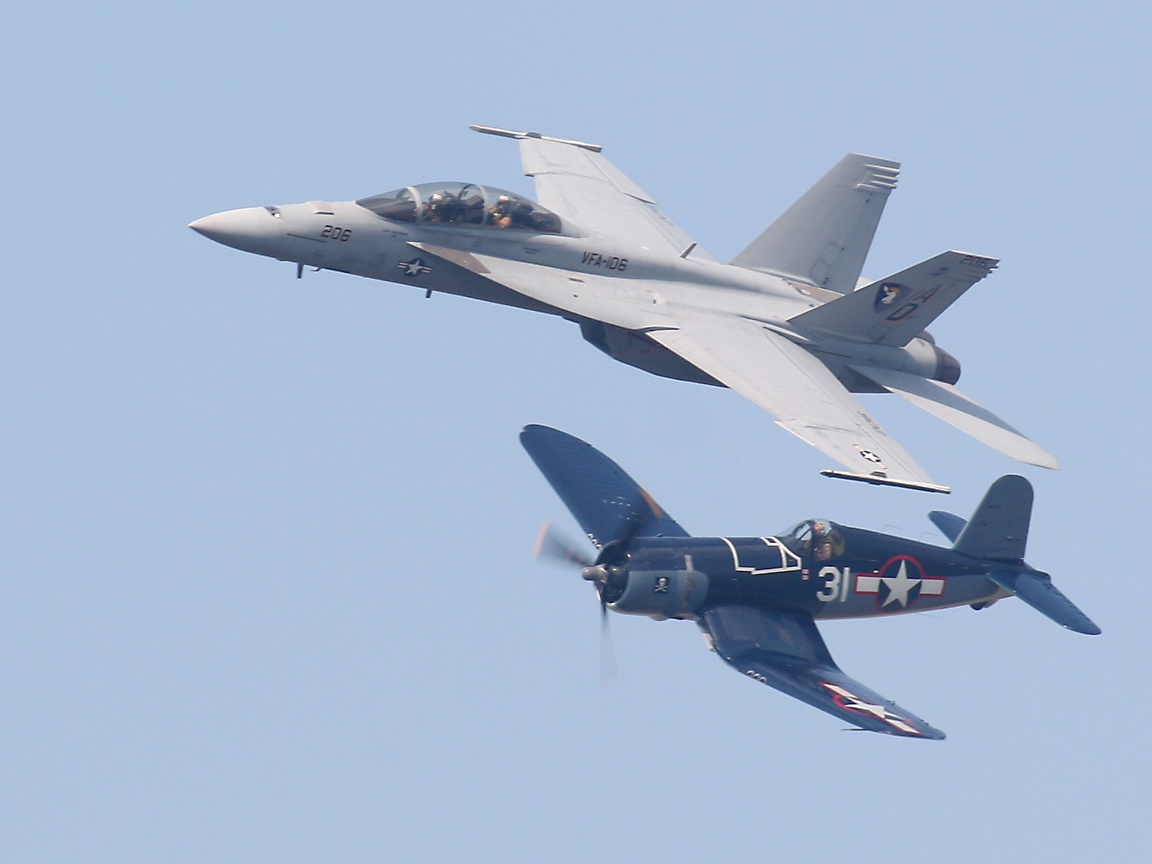

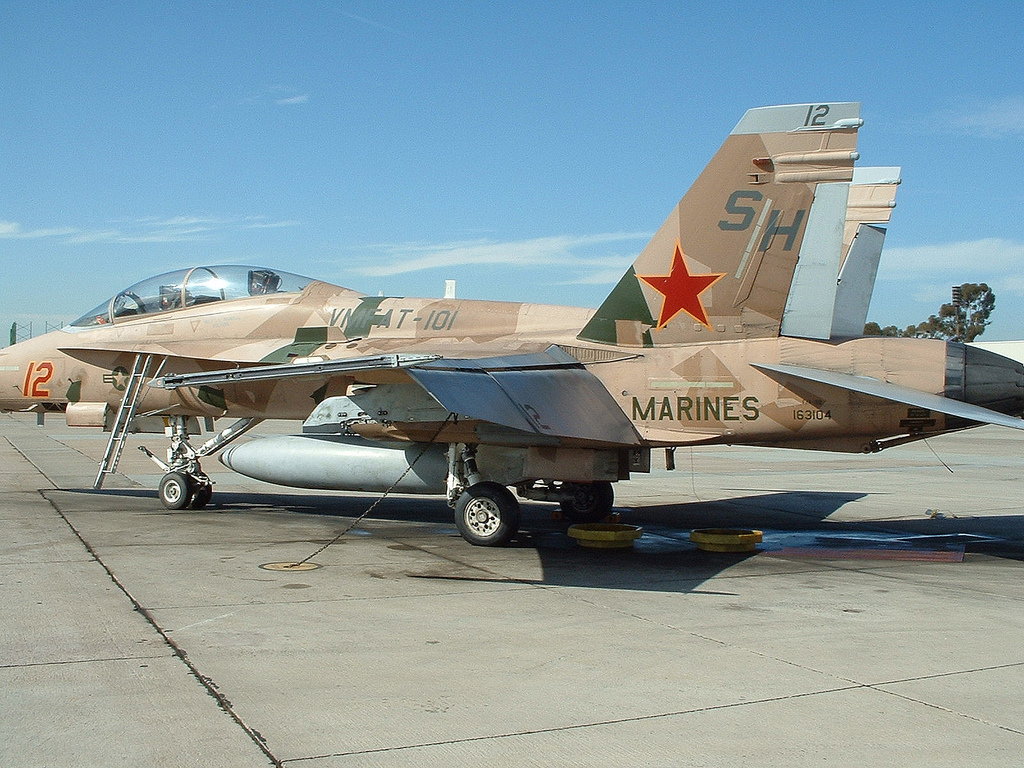

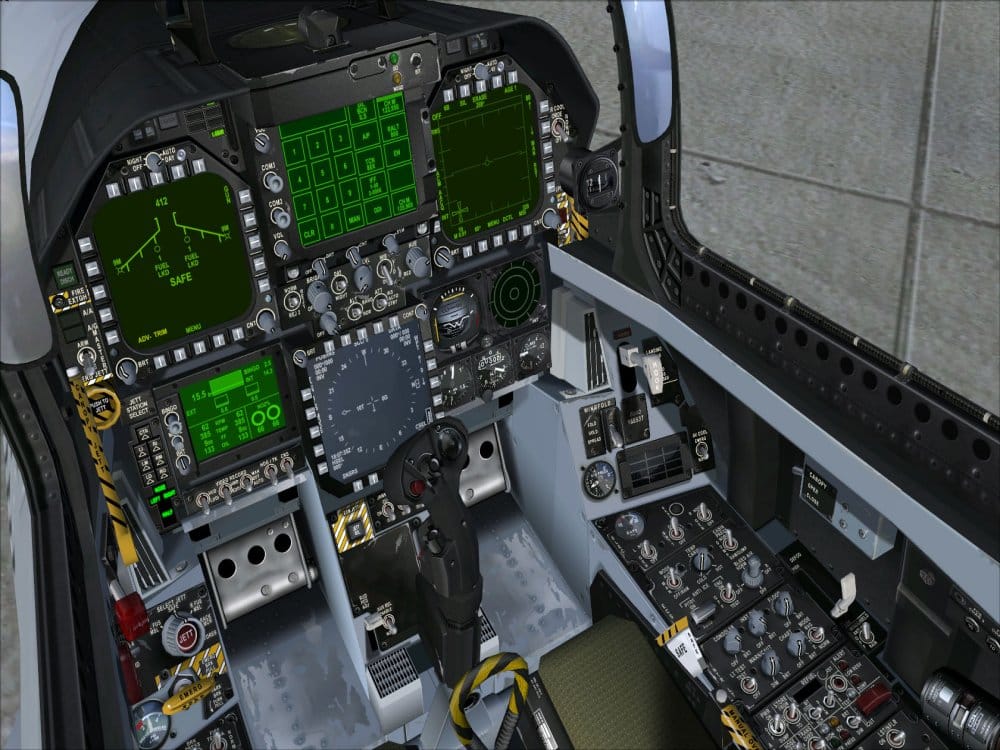

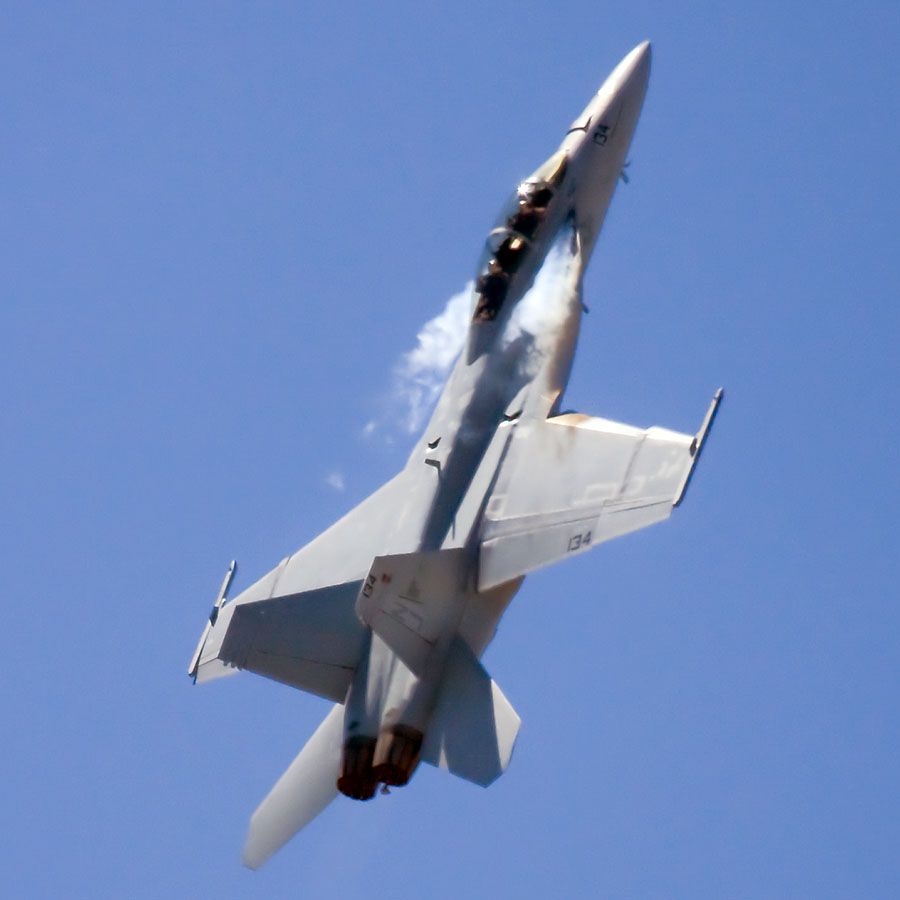
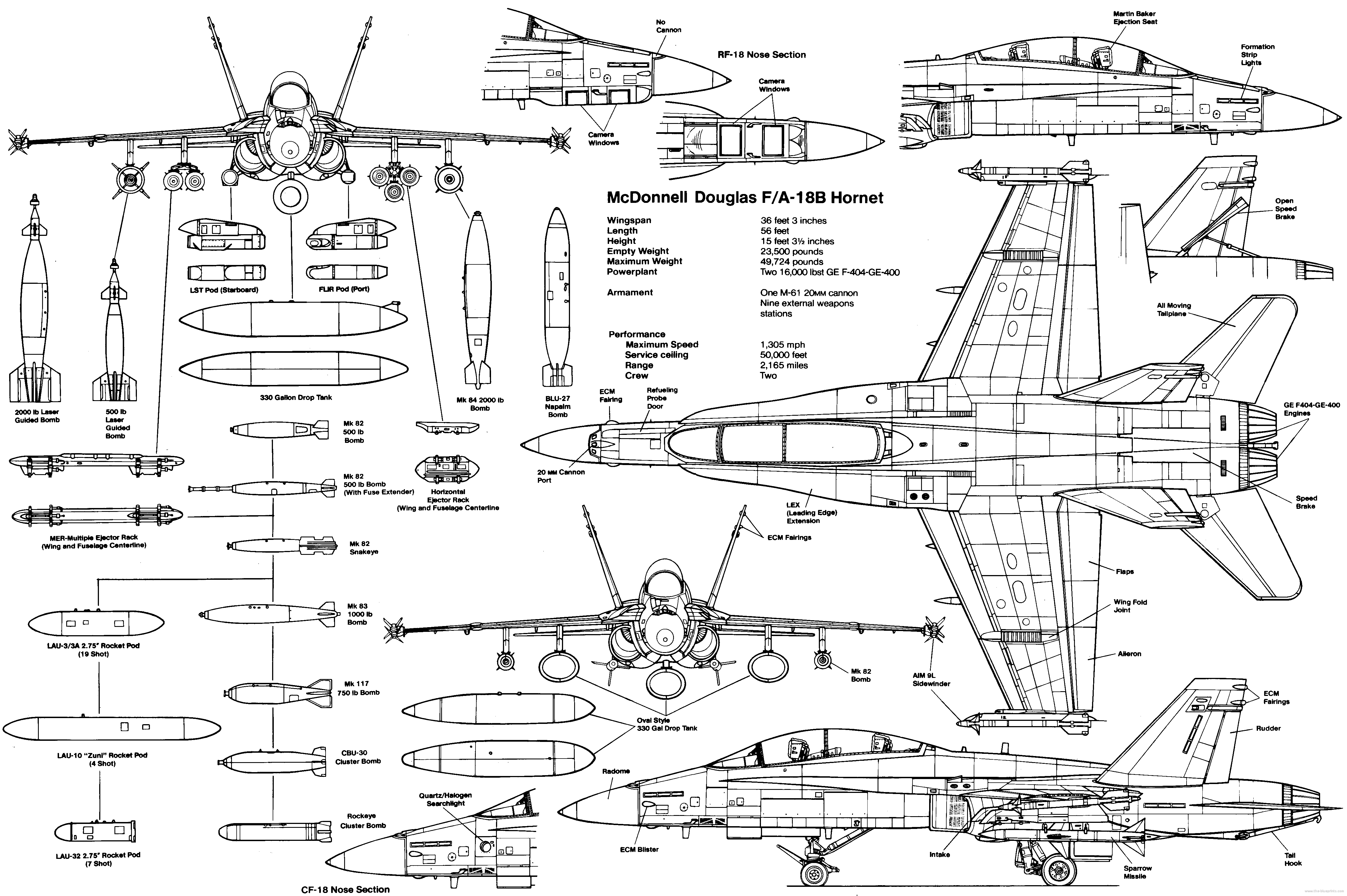




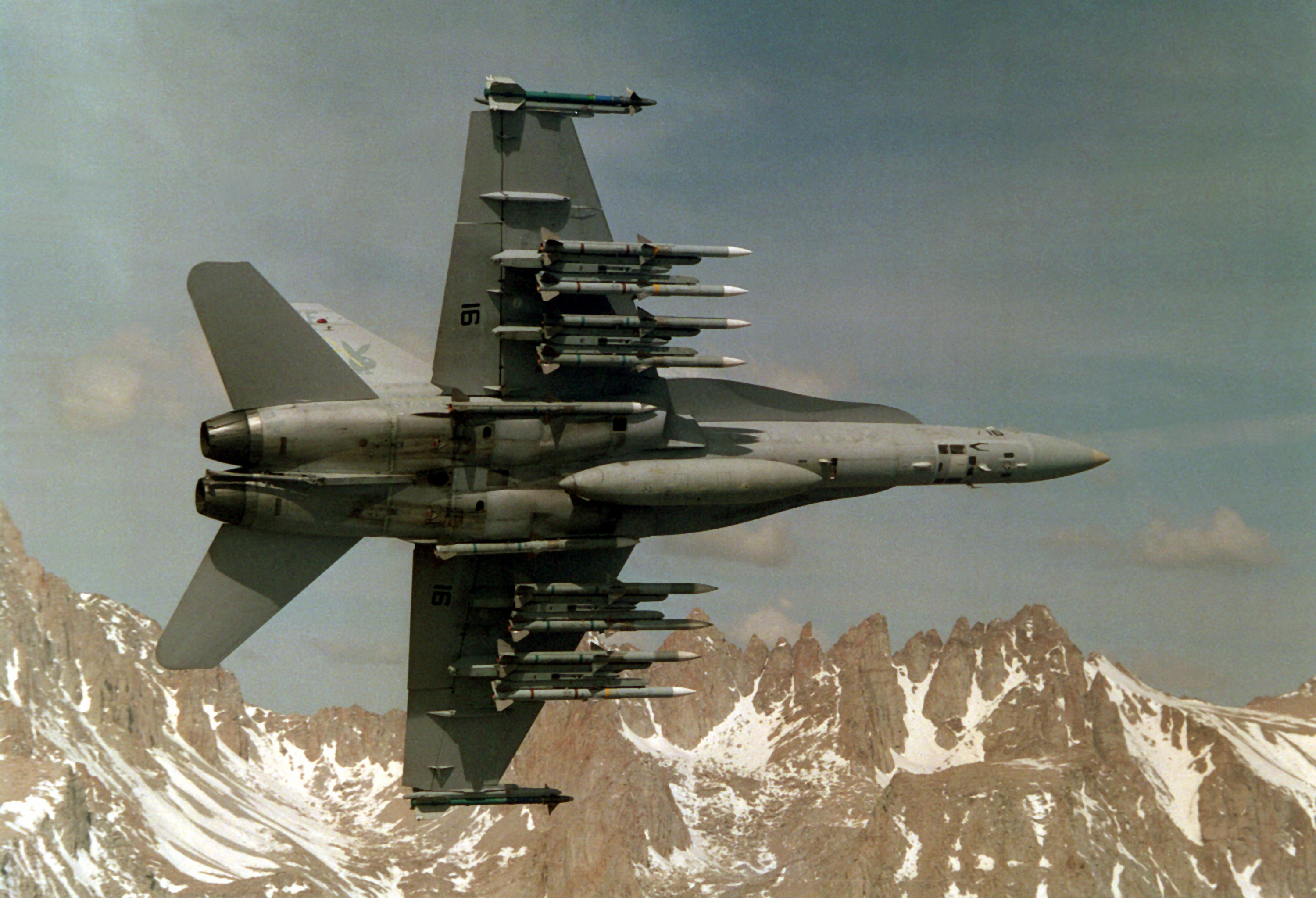

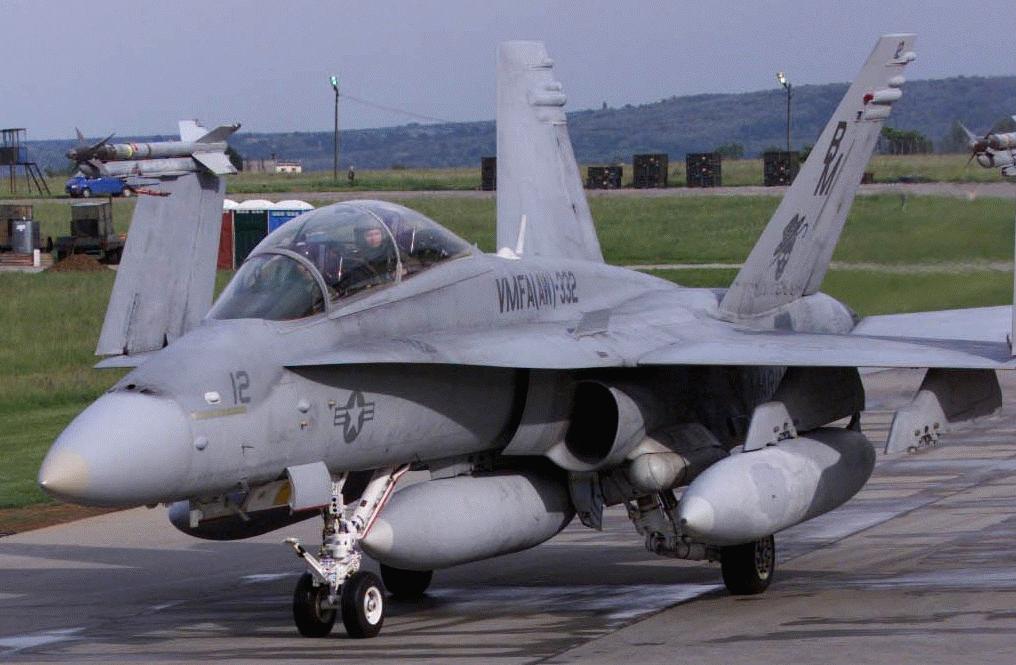

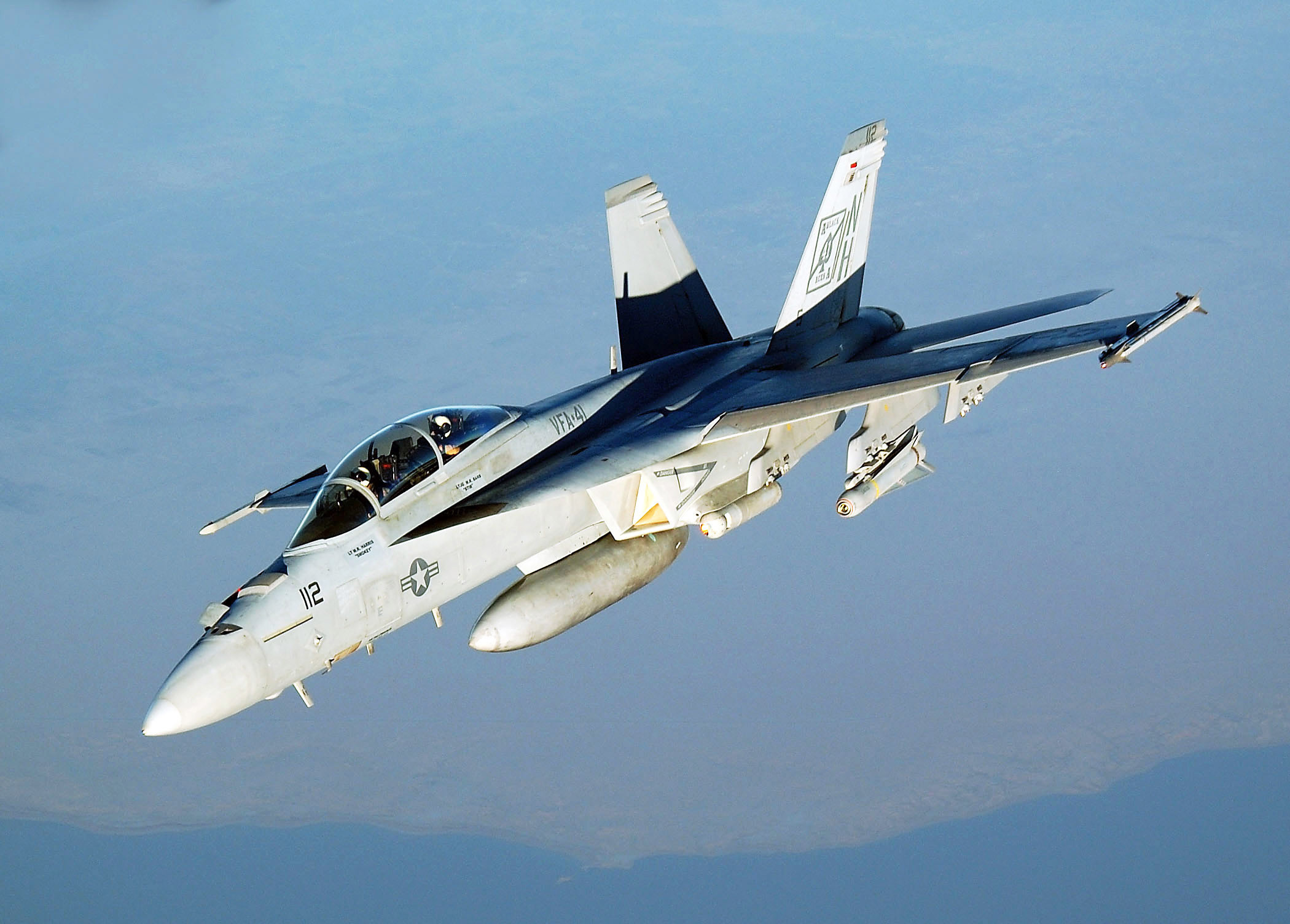




McDonnell Douglas F/A-18 Hornet
From Wikipedia, the free encyclopedia
"F-18" redirects here. For other uses, see F18.
| F/A-18 Hornet | |
|---|---|
 |
|
| A U.S. Marine Corps F/A-18C in October 2003, flying over the South China Sea. | |
| Role | Multirole fighter |
| National origin | United States |
| Manufacturer | McDonnell Douglas / Boeing Northrop |
| First flight | 18 November 1978 |
| Introduction | 7 January 1983 |
| Status | In service |
| Primary users | United States Navy United States Marine Corps Royal Australian Air Force Spanish Air Force |
| Number built | F/A-18A/B/C/D: 1,480[1] |
| Unit cost |
US$29–57 million (2006)[2]
|
| Developed from | Northrop YF-17 |
| Variants | McDonnell Douglas CF-18 Hornet High Alpha Research Vehicle |
| Developed into | Boeing F/A-18E/F Super Hornet Boeing X-53 Active Aeroelastic Wing |
The F/A-18 has a top speed of Mach 1.8 (1,190 mph or 1,915 km/h at 40,000 ft or 12,190 m). It can carry a wide variety of bombs and missiles, including air-to-air and air-to-ground, supplemented by the 20 mm M61 Vulcan cannon. It is powered by two General Electric F404 turbofan engines, which give the aircraft a high thrust-to-weight ratio. The F/A-18 has excellent aerodynamic characteristics, primarily attributed to its leading edge extensions (LEX). The fighter's primary missions are fighter escort, fleet air defense, Suppression of Enemy Air Defenses (SEAD), air interdiction, close air support and aerial reconnaissance. Its versatility and reliability have proven it to be a valuable carrier asset, though it has been criticized for its lack of range and payload compared to its earlier contemporaries, such as the Grumman F-14 Tomcat in the fighter and strike fighter role, and the Grumman A-6 Intruder and LTV A-7 Corsair II in the attack role.
The Hornet saw its first combat action in 1986 during Operation El Dorado Canyon and subsequently participated in 1991 Operation Desert Storm and 2003 Operation Iraqi Freedom. The F/A-18 Hornet provided the baseline design for the Boeing F/A-18E/F Super Hornet, a larger, evolutionary redesign of the F/A-18.
Development
Origins
The U.S. Navy started the Naval Fighter-Attack, Experimental (VFAX) program to procure a multirole aircraft to replace the Douglas A-4 Skyhawk, the A-7 Corsair II, and the remaining McDonnell Douglas F-4 Phantom IIs, and to complement the F-14 Tomcat. Vice Admiral Kent Lee, then head of Naval Air Systems Command (NAVAIR), was the lead advocate for the VFAX against strong opposition from many Navy officers, including Vice Admiral William D. Houser, deputy chief of naval operations for air warfare – the highest ranking naval aviator.[3]In August 1973, Congress mandated that the Navy pursue a lower-cost alternative to the F-14. Grumman proposed a stripped F-14 designated the F-14X, while McDonnell Douglas proposed a naval variant of the F-15, but both were nearly as expensive as the F-14.[4] That summer, Secretary of Defense Schlesinger ordered the Navy to evaluate the competitors in the Air Force's Lightweight Fighter (LWF) program, the General Dynamics YF-16 and Northrop YF-17.[5] The Air Force competition specified a day fighter with no strike capability. In May 1974, the House Armed Services Committee redirected $34 million from the VFAX to a new program, the Navy Air Combat Fighter (NACF),[5] intended to make maximum use of the technology developed for the LWF program.[4]
Redesigning the YF-17
Though the YF-16 won the LWF competition, the Navy was skeptical that an aircraft with one engine and narrow landing gear could be easily or economically adapted to carrier service, and refused to adopt an F-16 derivative. On 2 May 1975 the Navy announced its selection of the YF-17.[6] Since the LWF did not share the design requirements of the VFAX, the Navy asked McDonnell Douglas and Northrop to develop a new aircraft from the design and principles of the YF-17. On 1 March 1977 Secretary of the Navy W. Graham Claytor announced that the F-18 would be named "Hornet".[4]Northrop had partnered with McDonnell Douglas as a secondary contractor on NACF to capitalize on the latter's experience in building carrier aircraft, including the widely used F-4 Phantom II. On the F-18, the two companies agreed to evenly split component manufacturing, with McDonnell Douglas conducting final assembly. McDonnell Douglas would build the wings, stabilators, and forward fuselage; while Northrop would build the center and aft fuselage and vertical stabilizers. McDonnell Douglas was the prime contractor for the naval versions, and Northrop would be the prime contractor for the F-18L land-based version which Northrop hoped to sell on the export market.[4][5]
The F-18, initially known as McDonnell Douglas Model 267, was drastically modified from the YF-17. For carrier operations, the airframe, undercarriage, and arrestor hook were strengthened, folding wings and catapult attachments were added, and the landing gear widened.[7] To meet Navy range and reserves requirements, McDonnell increased fuel capacity by 4,460 pounds (2,020 kg), by enlarging the dorsal spine and adding a 96 gallon fuel tank to each wing. A "snag" was added to the wing's leading edge and stabilators to prevent a flutter discovered in the F-15 stabilator. The wings and stabilators were enlarged, the aft fuselage widened by 4 inches (102 mm), and the engines canted outward at the front. These changes added 10,000 lb (4,540 kg) to the gross weight, bringing it to 37,000 lb (16,800 kg). The YF-17's control system was replaced with a fully digital fly-by-wire system with quadruple-redundancy, the first to be installed in a production fighter.[7]
Originally, it was planned to acquire a total of 780 aircraft of three variants: the single seat F-18A fighter and A-18A attack aircraft, differing only in avionics; and the dual-seat TF-18A, which retained full mission capability of the F-18 with a reduced fuel load.[8] Following improvements in avionics and multifunction displays, and a redesign of stores stations, the A-18A and F-18A were able to be combined into one aircraft.[4] Starting in 1980, the aircraft began to be referred to as the F/A-18A, and the designation was officially announced on 1 April 1984. The TF-18A was redesignated F/A-18B.[4]
Northrop's F-18L
Northrop developed the F-18L as a potential export aircraft. Since it was not strengthened for carrier service, it was expected to be lighter and better performing, and a strong competitor to the F-16 Fighting Falcon then being offered to American allies. The F-18L's maximum gross weight was 7,700 pounds (3,490 kg) (approximately 30%) lighter than the F/A-18A, via lighter landing gear, lack of wing folding mechanism, reduced part thickness in areas, and lower fuel-carrying capacity. Though the aircraft retained a lightened arresting hook, the most obvious external difference was removed "snags" on the leading edge of the wings and stabilators. It still retained 71% commonality with the F/A-18 by parts weight, and 90% of the high-value systems, including the avionics, radar, and ECM suite, though alternatives were offered. Unlike the F/A-18, the F-18L carried no fuel in its wings and lacked weapons stations on the intakes. It had three underwing pylons on each side instead.[9]The F/A-18L version followed to coincide with the US Navy's F/A-18A as a land-based export alternative. This was essentially an F/A-18A lightened by approximately 2,500 to 3,000 pounds (1,130 to 1,360 kg); weight was reduced by removing the folding wing and associated actuators, by implementing a simpler landing gear (single wheel nose gear and cantilever oleo main gear), and change to a land-based tail-hook. The revised F/A-18L included wing fuel tanks and fuselage stations of the F/A-18A. Its weapons capacity would increase from 13,700 to 20,000 pounds (6,210 to 9,070 kg); largely due to the addition of a third underwing pylon and strengthened wingtips (11 stations in total vs 9 stations of the F/A-18A). Compared to the F-18L, the outboard weapons pylons are moved closer to the wingtip missile rails. Because of the strengthened non-folding wing, the wingtip missile rails were designed to carry either the AIM-7 Sparrow or Skyflash medium-range air-to-air missiles, in addition to the AIM-9 Sidewinder as found on the F/A-18A. The F/A-18L was strengthened for a 9 g design load factor compared to the F/A-18A's 7.5 g factor.[10]
The partnership between McDonnell Douglas and Northrop soured over competition for foreign sales for the two models. Northrop felt that McDonnell Douglas would put the F/A-18 in direct competition with the F-18L. In October 1979, Northrop filed a series of lawsuits charging that McDonnell was using Northrop technology developed for the F-18L for foreign sales in violation of their agreement, and asked for a moratorium on foreign sales of the Hornet via McDonnell Douglas. The case was resolved in 1985 when McDonnell agreed to pay Northrop $50 million for complete rights to the design, with no admission of wrongdoing. By then Northrop had ceased work on the F-18L, and most export orders were captured by the F-16 or the F/A-18.[9]
Into production
During flight testing, the snag on the leading edge of the stabilators was filled in, and the gap between the Leading edge extensions (LEX) and the fuselage mostly filled in. The gaps, called the boundary layer air discharge (BLAD) slots, controlled the vortices generated by the LEX and presented clean air to the vertical stabilizers at high angles of attack, but they also generated a great deal of parasitic drag, worsening the problem of the F/A-18's inadequate range. McDonnell filled in 80% of the gap, leaving a small slot to bleed air from the engine intake. This may have contributed to early problems with fatigue cracks appearing on the vertical stabilizers due to extreme aerodynamic loads, resulting in a short grounding in 1984 until the stabilizers were strengthened. Starting in May 1988, a small vertical fence was added to the top of each LEX to broaden the vortices and direct them away from the vertical stabilizers. This also provided a minor increase in controllability as a side effect.[11] F/A-18s of early versions had a problem with insufficient rate of roll, exacerbated by the insufficient wing stiffness, especially with heavy underwing ordnance loads.The first production F/A-18A flew on 12 April 1980. After a production run of 380 F/A-18As[12] (including the nine assigned to flight systems development), manufacture shifted to the F/A-18C in September 1987.[8]
Improvements and design changes
In the 1990s, the U.S. Navy faced the need to replace its aging A-6 Intruders, and A-7 Corsair IIs with no replacement in development.[13] To answer this deficiency, the Navy commissioned development of the F/A-18E/F Super Hornet. Despite its designation, it is not just an upgrade of the F/A-18 Hornet, but rather, a new, larger airframe using the design concepts of the Hornet. Hornets and Super Hornets will serve complementary roles in the U.S. Navy carrier fleet until the Hornet A-D models are completely replaced by the F-35C Lightning II.The Marines have chosen to extend the use of certain of their F/A-18s up to 10000 flight hours, due to delays in the F-35B version.[14]
Design
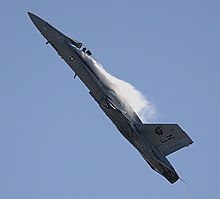
A Hornet performing a high-g pull-up during an air show. The high angle of attack causes powerful vortices to form at the leading edge extensions.
Canted vertical stabilizers are another distinguishing design element, one among several other such elements that enable the Hornet's excellent high angle-of-attack ability include oversized horizontal stabilators, oversized trailing edge flaps that operate as flaperons, large full-length leading edge slats, and flight control computer programming that multiplies the movement of each control surface at low speeds and moves the vertical rudders inboard instead of simply left and right. The Hornet's normally high angle-of-attack performance envelope was put to rigorous testing and enhanced in the NASA F-18 High Alpha Research Vehicle (HARV). NASA used the F-18 HARV to demonstrate flight handling characteristics at high angle-of-attack (alpha) of 65–70 degrees using thrust vectoring vanes.[16] F/A-18 stabilators were also used as canards on NASA's F-15S/MTD.
The Hornet is also notable for having been designed to reduce maintenance, and as a result has required far less downtime than its heavier counterparts, the F-14 Tomcat and the A-6 Intruder. Its mean time between failure is three times greater than any other Navy strike aircraft, and requires half the maintenance time.[8] Its General Electric F404 engines were also innovative in that they were designed with operability, reliability and maintainability first. The engine, while unexceptional in rated performance, demonstrates exceptional robustness under various conditions and is resistant to stall and flameout.[17] The F404 engine connects to the airframe at only 10 points and can be replaced without special equipment; a four person team can remove the engine within 20 minutes.[18]
A 1989 USMC study found that single seat fighters were well suited to air to air combat missions while dual seat fighters were favored for complex strike missions against heavy air and ground defenses in adverse weather–the question being not so much as to whether a second pair of eyes would be useful, but as to having the second crewman sit in the same fighter or in a second fighter. Single-seat fighters that lacked wingmen were shown to be especially vulnerable.[20]
Operational history
United States
Entry into service
Following trials and operational testing by VX-4 and VX-5, Hornets began to fill the Fleet Replacement Squadrons (FRS) VFA-125, VFA-106, and VMFAT-101, where pilots are introduced to the F/A-18. The Hornet entered operational service with Marine Corps squadron VMFA-314 at MCAS El Toro on 7 January 1983,[12] and with Navy squadron VFA-25 in March 1983, replacing F-4s and A-7Es, respectively.[8]
The initial fleet reports were complimentary, indicating that the Hornet was extraordinarily reliable, a major change from its predecessor, the F-4J.[22] Other squadrons that switched to F/A-18 are VFA-146 "Blue diamonds", and VFA-147 "Argonauts". In January 1985, the VFA-131 "Wildcats" and the VFA-132 "Privateers" moved from Naval Air Station Lemoore, California to Naval Air Station Cecil Field, Florida, and became the Atlantic Fleet's first F/A-18 squadrons.
Combat operations
The F/A-18 first saw combat action in April 1986, when VFA-131, VFA-132, VMFA-314, and VMFA-323 Hornets from USS Coral Sea flew SEAD missions against Libyan air defenses during Operation Prairie Fire and an attack on Benghazi as part of Operation El Dorado Canyon.[23]During the Gulf War of 1991, the Navy deployed 106 F/A-18A/C Hornets and Marine Corps deployed 84 F/A-18A/C/D Hornets.[24] F/A-18 pilots were credited with two kills during the Gulf War, both MiG-21s.[25] On 17 January, the first day of the war, U.S. Navy pilots Lieutenant Commander Mark I. Fox and his wingman, Lieutenant Nick Mongilio were sent from the USS Saratoga in the Red Sea to bomb an airfield in southwestern Iraq. While en route, they were warned by an E-2C of approaching MiG-21 aircraft. The Hornets shot down the two MiGs with AIM-7 and AIM-9 missiles in a brief dogfight. The F/A-18s, each carrying four 2,000 lb (910 kg) bombs, then resumed their bombing run before returning to Saratoga.[12][26]
The Hornet's survivability was demonstrated when a Hornet took hits in both engines and flew 125 mi (201 km) back to base. It was repaired and flying within a few days. F/A-18s flew 4,551 sorties with 10 Hornets damaged including two losses.[27] The two losses were U.S. Navy F/A-18s and their pilots were lost. On 17 January 1991, Lieutenant Commander Scott Speicher of VFA-81 was shot down and killed in the crash of his aircraft.[28] An unclassified summary of a 2001 CIA report suggests that Speicher's aircraft was shot down by a missile fired from an Iraqi Air Force aircraft,[29][30] most likely a MiG-25.[31] The other F/A-18, piloted by Lieutenant Robert Dwyer was lost over the North Persian Gulf after a successful mission to Iraq; he was officially listed as killed in action, body not recovered.
Both U.S. Navy F/A-18A/C models and Marine F/A-18A/C/D models were used continuously in Operation Southern Watch and over Bosnia and Kosovo in the 1990s. U.S. Navy Hornets flew during Operation Enduring Freedom in 2001 from carriers operating in the North Arabian Sea. Both the F/A-18A/C and newer F/A-18E/F variants were used during Operation Iraqi Freedom in 2003, operating from aircraft carriers as well from an air base in Kuwait. Later in the conflict USMC A+, C, and primarily D models operated from bases within Iraq.
An F/A-18C was accidentally downed in a friendly fire incident by a Patriot missile when a pilot tried to evade two missiles fired at him and crashed.[32] Two others collided over Iraq in May 2005. In January 2007, two Navy F/A-18E/F Super Hornets collided in midair and crashed in the Persian Gulf.[33]
Non-U.S. service
Though U.S. Navy aircraft have generally not sold well on the export market, the F/A-18 has been purchased and is in operation with several foreign air services. Export Hornets are typically similar to U.S. models of a similar manufacture date. Since none of the customers operate aircraft carriers, all export models have been sold without the automatic carrier landing system, and Royal Australian Air Force further removed the catapult attachment on the nose gear.[22] Except for Canada, all export customers purchased their Hornets through the U.S. Navy, via the U.S. Foreign Military Sales (FMS) Program, where the Navy acts as the purchasing manager but incurs no financial gain or loss. Canada, the largest Hornet operator outside of the U.S., ordered its aircraft directly from the manufacturer.Australia
Main article: McDonnell Douglas F/A-18 Hornet in Australian service
The first two aircraft were produced in the US, with the remainder assembled in Australia at Government Aircraft Factories. F/A-18 deliveries to the RAAF began on 29 October 1984, and continued until May 1990.[38] In 2001, Australia deployed four aircraft to Diego Garcia, in an air defense role, during coalition operations against the Taliban in Afghanistan. In 2003, 75 Squadron deployed 14 F/A-18s to Qatar as part of Operation Falconer and these aircraft saw action during the invasion of Iraq.[39] Australia had 71 Hornets in service in 2006, after four were lost to crashes.[34]
The fleet was upgraded beginning in the late 1990s to extend their service lives to 2015.[40] They were expected to be retired then and replaced by the F-35 Lightning II.[41][42] Several of the Australian Hornets have had refits applied to extend their service lives until the planned retirement date of 2020.[43] In addition to the F/A-18A and F/A-18B Hornets, Australia has purchased 24 F/A-18F Super Hornets, with deliveries beginning in 2009.
Canada
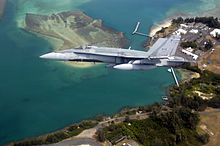
Canadian CF-188A Hornet off the coast of Hawaii. Note the "false
cockpit" painted on the underside of the aircraft, intended to confuse
enemy pilots during dogfights.
Main article: McDonnell Douglas CF-18 Hornet
Canada was the first export customer for the Hornet, replacing the CF-104 Starfighter (air reconnaissance & strike), the McDonnell CF-101 Voodoo (air interception) and the CF-116 Freedom Fighter (ground attack). The Canadian Forces Air Command ordered 98 A models (Canadian designation CF-188A/CF-18A) and 40 B models (designation CF-188B/CF-18B).In 1991, Canada committed 26 CF-18s to the Gulf War, based in Qatar. These aircraft primarily provided Combat Air Patrol duties, although late in the air war began to perform air strikes on Iraqi ground targets. On 30 January 1991, two CF-18s on CAP detected and attacked an Iraqi TNC-45 patrol boat. The vessel was repeatedly strafed and damaged by 20mm cannon fire, but an attempt to sink the ship with an air to air missile failed. The ship was subsequently sunk by American aircraft, but the Canadian CF-18s received partial credit for its destruction.[44] In June 1999, 18 CF-18s were deployed to Aviano AB, Italy, where they participated in both the air-to-ground and air-to-air roles in the former Yugoslavia.
62 CF-18A and 18 CF-18B aircraft took part in the Incremental Modernization Project which was completed in two phases. The program was launched in 2001 and the last updated aircraft was delivered in March 2010. The aims were to improve air-to-air and air-to-ground combat abilities, upgrade sensors and the defensive suite, and replace the datalinks and communications systems on board the CF-18 from the F/A-18A and F/A-18B standard to the current F/A-18C and D standard.[45][46]
In July 2010 the Canadian government announced plans to replace the remaining CF-18 fleet with 65 F-35 Lightning IIs, with deliveries scheduled to start in 2016.[47]
Finland
One fighter was destroyed in a mid-air collision in 2001. A damaged F-18C was rebuilt into a F-18D using the forward section of a Canadian CF-18B that was purchased.[49] The modified fighter crashed during a test flight in January 2010.[50] The cause of the crash was determined to be due to a faulty tailplane servo cylinder.[51]
Finland is upgrading its fleet of F-18s with new avionics, including helmet mounted sights (HMS), new cockpit displays, sensors and standard NATO data link. Several of the remaining Hornets are going to be fitted to carry air-to-ground ordnance such as the AGM-158 JASSM, in effect returning to the original F/A-18 multi-role configuration. The upgrade includes also the procurement and integration of new AIM-9X Sidewinder and AIM-120C-7 AMRAAM air-to-air missiles. This Mid-Life Upgrade (MLU) is estimated to cost between €1–1.6 billion and work is scheduled to be finished by 2016. After the upgrades the aircraft are to remain in active service until 2020–2025.[52][53]
Kuwait
The Kuwait Air Force (Al Quwwat Aj Jawwaiya Al Kuwaitiya) ordered 32 F/A-18C and eight F/A-18D Hornets in 1988 and delivery started in October 1991.[54] The F/A-18C/Ds replaced A-4KU Skyhawk. Kuwait Air Force Hornets have flown missions over Iraq during Operation Southern Watch in the 1990s. They have also participated in military exercises with the air forces of other Gulf nations.[55] Kuwait had 39 F/A-18C/D Hornets in service in 2008.[56]Malaysia
Spain
The Spanish Air Force (Ejército del Aire) ordered 60 EF-18A model and 12 EF-18B model Hornets (the "E" standing for "España", Spain), named respectively as C.15 and CE.15 by Spanish AF.[60] Delivery of the Spanish version started on 22 November 1985.[12] These fighters were upgraded to F-18A+/B+ standard, close to F/A-18C/D (plus version includes later mission and armament computers, databuses, data-storage set, new wiring, pylon modifications and software, new abilities as AN/AAS-38B NITE Hawk targeting FLIR pods).In 1995 Spain obtained 24 ex-USN F/A-18A Hornets, with six more on option. These were delivered from December 1995 until December 1999. Before delivery, they were modified to EF-18A+ standard.[61] This was the first sale of USN surplus Hornets.
Spanish Hornets operate as an all-weather interceptor 60% of the time and as an all-weather day/night attack aircraft for the remainder. In case of war, each of the front-line squadrons would take a primary role: 121 is tasked with tactical air support and maritime operations; 151 and 122 are assigned to all-weather interception and air combat roles; and 152 is assigned the SEAD mission. Air refueling is provided by KC-130Hs and Boeing 707TTs. Pilot conversion to EF-18 is centralized in 153 Squadron (Ala 15). Squadron 462's role is air defense of the Canary Islands, being responsible for fighter and attack missions from Gando AB.
Spanish Air Force EF-18 Hornets have flown Ground Attack, SEAD, combat air patrol (CAP) combat missions in Bosnia and Kosovo, under NATO command, in Aviano detachment (Italy). They shared the base with Canadian and USMC F/A-18s. Six Spanish Hornets had been lost in accidents by 2003.[60]
Over Yugoslavia, eight EF-18s, based at Aviano AB, participated in bombing raids in Operation Allied Force in 1999. Over Bosnia, they also performed missions for air-to-air combat air patrol, close air support air-to-ground, photo reconnaissance, forward air controller-airborne, and tactical air controller-airborne. Over Libya, four Spanish Hornets participated in enforcing a no-fly zone.[62]
Switzerland
The Swiss Air Force purchased 26 C models and eight D models.[60] Delivery of the aircraft started in January 1996.[12] Two D models had been lost in crashes as of 2013.[63][importance?]In late 2007, Switzerland requested to be included in F/A-18C/D Upgrade 25 Program, to extend the useful life of its F/A-18C/Ds. The program includes significant upgrades to the avionics and mission computer, 20 ATFLIR surveillance and targeting pods, and 44 sets of AN/ALR-67v3 ECM equipment. In October 2008 the Swiss Hornet fleet reached the 50,000 flight hour milestone.[64]
Potential operators
The F/A-18C and F/A-18D were considered by the French Navy (Marine Nationale) during the 1980s for deployment on their aircraft carriers Clemenceau and Foch[65] and again in the 1990s for the later nuclear-powered Charles de Gaulle,[66] in the event that the Dassault Rafale M was not brought into service when originally planned.Austria,[67] Chile,[22] Czech Republic,[67] Hungary,[67] Philippines,[67] Poland,[67] and Singapore[22] evaluated the Hornet but did not purchase it. Thailand ordered four C and four D model Hornets but the Asian financial crisis in the late 1990s resulted in the order being canceled. The U.S. DoD then purchased the Hornets in production for the Marine Corps.[22]
The F/A-18A and F-18L land-based version competed for a fighter contract from Greece in the 1980s.[68] The Greek government chose F-16 and Mirage 2000 instead.
Variants
A/B
The F/A-18A is the single-seat variant and the F/A-18B is the two-seat variant. The space for the two-seat cockpit is provided by a relocation of avionics equipment and a 6% reduction in internal fuel; two-seat Hornets are otherwise fully combat-capable. The B-model is used primarily for training.In 1992, the original Hughes AN/APG-65 radar was replaced with the Hughes (now Raytheon) AN/APG-73, a faster and more capable radar. A-model Hornets that have been upgraded to the AN/APG-73 are designated F/A-18A+.
C/D
The F/A-18C is the single-seat variant and the F/A-18D is the two-seat variant. The D-model can be configured for training or as an all-weather strike craft. The "missionized" D model's rear seat is configured for a Marine Corps Naval Flight Officer who functions as a Weapons and Sensors Officer to assist in operating the weapons systems. The F/A-18D is primarily operated by the U.S. Marine Corps in the night attack and Forward Air Controller (Airborne) (FAC(A)) roles.[69]The F/A-18C and D models are the result of a block upgrade in 1987[12] incorporating upgraded radar, avionics, and the capacity to carry new missiles such as the AIM-120 AMRAAM air-to-air missile and AGM-65 Maverick[8] and AGM-84 Harpoon air-to-surface missiles. Other upgrades include the Martin-Baker NACES (Navy Aircrew Common Ejection Seat), and a self-protection jammer. A synthetic aperture ground mapping radar enables the pilot to locate targets in poor visibility conditions. C and D models delivered since 1989 also have improved night attack abilities, consisting of the Hughes AN/AAR-50 thermal navigation pod, the Loral AN/AAS-38 NITE Hawk FLIR (forward looking infrared array) targeting pod, night vision goggles, and two full-color (formerly monochrome) multi-function display (MFDs) and a color moving map.[8]
In addition, 60 D-model Hornets are configured as the night attack F/A-18D (RC) with ability for reconnaissance.[69] These could be outfitted with the ATARS electro-optical sensor package that includes a sensor pod and equipment mounted in the place of the M61 cannon.[70]
Beginning in 1992, the F404-GE-402 enhanced performance engine, providing approximately 10% more maximum static thrust became the standard Hornet engine.[71] Since 1993, the AAS-38A NITE Hawk added a designator/ranger laser, allowing it to self-mark targets. The later AAS-38B added the ability to strike targets designated by lasers from other aircraft.[72]
Production of the F/A-18C ended in 1999. In 2000, the last F/A-18D was delivered to the U.S. Marine Corps.[12]
E/F Super Hornet
Main article: Boeing F/A-18E/F Super Hornet
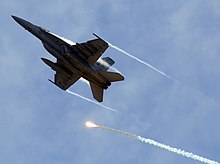
A VFA-11 F/A-18F Super Hornet performing evasive maneuvers during an air power demonstration above USS Harry S.
Truman (CVN-75)
Truman (CVN-75)
The EA-18G Growler is an electronic warfare version of the two-seat F/A-18F, which entered production in 2007. The Growler is replacing the Navy's EA-6B Prowler and carries a Naval Flight Officer as a second crewman in an Electronic Countermeasures Officer (ECMO) role.
The Super Hornet is also operated by Australia.
Other US variants
- F-18(R)
- This was a proposed reconnaissance version of the F/A-18A. It included a sensor package that replaced the 20 mm cannon. The first of two prototypes flew in August 1984. Small numbers were produced.[70]
- RF-18D
- Proposed two-seat reconnaissance version for the US Marine Corps in the mid-1980s. It was to carry a radar reconnaissance pod. The system was canceled after it was unfunded in 1988. This ability was later realized on the F/A-18D(RC).[70]
- TF-18A
- Two-seat training version of the F/A-18A fighter, later redesignated F/A-18B.[4]
- F-18 HARV
- Single-seat High Alpha Research Vehicle for NASA.[73] High angles of attack using thrust vectoring, modifications to the flight controls, and forebody strakes
- X-53 Active Aeroelastic Wing
- A NASA F/A-18 has been modified to demonstrate the Active Aeroelastic Wing technology, and was designated X-53 in December 2006.
Export variants
These designations are not part of 1962 United States Tri-Service aircraft designation system.- F-18L
- This was a lighter land-based version of the F/A-18 Hornet. It was designed to be a single-seat air-superiority fighter and ground-attack aircraft. It was originally intended to be assembled by Northrop as the export version of the F/A-18 Hornet. The F-18L was lighter via removing carrier landing capability. Despite the advantages, customers preferred the standard Hornet, and the F-18L never entered mass production.[22]
- (A)F/A-18A/B
- (A)F/A-18A: Single-seat fighter/attack version for the Royal Australian Air Force.
- (A)F/A-18B: Two-seat training version for the Royal Australian Air Force.
- "F/A-18A" was the original company designation, designations of "AF-18A" & "ATF-18A" have also been applied. Assembled in Australia (excluding the first two (A)F/A-18Bs) by Aero-Space Technologies of Australia (ASTA) from 1985 through to 1990, from kits produced by McDonnell Douglas with increasing local content in the later aircraft. Originally the most notable differences between an Australian (A)F/A-18A/B and a US F/A-18A/B were the lack of a catapult attachment, replacing the carrier tailhook with a lighter land arresting hook, and the automatic carrier landing system with an Instrument Landing System. Australian Hornets have been involved in several major upgrade programs. This program called HUG (Hornet Upgrade) has had a few evolutions over the years. The first was to give Australian Hornets F/A-18C model avionics. The second and current upgrade program (HUG 2.2) updates the fleet's avionics even further.
- CF-18A: Single-seat fighter/attack version for the Royal Canadian Air Force. The official Canadian designation is CF-188A Hornet.
- CF-18B: Two-seat training and combat version for the Royal Canadian Air Force. The official Canadian designation is CF-188B Hornet.
- EF-18 Hornet
- EF-18A: Single-seat fighter/attack version for the Spanish Air Force. The Spanish Air Force designation is C.15.
- EF-18B: Two-seat training version for the Spanish Air Force. The Spanish Air Force designation is CE.15.
- KAF-18 Hornet
- KAF-18C: Single-seat fighter/attack version for the Kuwait Air Force[54]
- KAF-18D: Two-seat training version for the Kuwait Air Force[54]
- The Finnish Air Force uses F/A-18C/D Hornets, with a Finland-specific mid-life update. The first seven Hornets (D models) were produced by McDonnell Douglas.[48] The 57 single-seat F-18C model units were assembled by Patria in Finland.[74]
- F-18C/D Hornet
- Switzerland uses F-18C/D,[75] later Swiss specific mid-life update. The Swiss F-18s had no ground attack capability originally, until hardware was retrofitted.
Operators
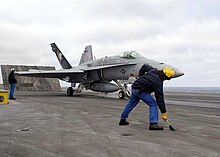
U.S. Navy F/A-18C from VFA-131 launches from French
aircraft carrier Charles de Gaulle
off the Virginia Capes.
For operators of F/A-18E and F Super Hornets and its export variants, see Boeing F/A-18E/F Super Hornet.
- Royal Australian Air Force - 55 F/A-18A and 16 F/A-18Bs in operation as of 2008[76]
- Finnish Air Force - 55 F-18Cs and 7 F-18Ds in use as of 2013[77]
- Kuwait Air Force - 28 F/A-18Cs and seven F/A-18Ds in service as of November 2008[76]
- Royal Malaysian Air Force - eight F/A-18Ds in operation as of November 2008.[76]
- 18 Squadron[79]
- Spanish Air Force
- Ala de Caza 15 (15th Fighter Wing) Zaragoza AB, with 30 A+ and six B+ shared between Squadrons 151, 152 and 153
- Ala de Caza 12, Torrejón AB (Squadron 121 and 122) with 30 A+ and six B+.
- Ala 46, Gando AB (Canary islands), with Squadron 462 operating 22 ex-US Navy F/A-18s.[80]
- Swiss Air Force - 26 F/A-18Cs and seven F/A-18Ds in use as of November 2008[76]
- United States Navy[83][84] - 409 F/A-18A/B/C/D Hornets in operation as of 2008[76]
- VFC-12 1990–present (Naval Air Reserve)
- VFA-15 1992–present
- VFA-22 1990–2004 (initially converted to F/A-18E Super Hornet, 2004–2007; subsequently converted to F/A-18F Super Hornet, 2007–present)
- VFA-25 1983–present (converted to F/A-18E Super Hornet)
- VFA-27 1991–2004 (converted to F/A-18E Super Hornet)
- VFA-34 1996–present
- VFA-37 1990–present
- VFA-81 1988–2008 (converted to F/A-18E Super Hornet)
- VFA-82 1987–2005 (Disestablished)
- VFA-83 1988–present
- VFA-86 1987–2012 (converted to F/A-18E Super Hornet)
- VFA-87 1986–present
- VFA-94 1990–present
- VFA-97 1991–present (converted to F/A-18E Super Hornet)
- VFA-105 1990–2006 (converted to F/A-18E Super Hornet)
- VFA-106 1984–present
- VFA-115 1996–2001 (converted to F/A-18E Super Hornet)
- VFA-125 1980–2010 (Disestablished, aircraft transferred to VFA-122, Legacy Hornets phased out by 2013)
- VFA-127 1989–1996 (Disestablished)
- VFA-131 1983–present
- VFA-132 1984–1992 (Disestablished)
- VFA-136 1985–present
- VFA-137 1985–2003 (converted to F/A-18E Super Hornet)
- VFA-146 1989–present
- VFA-147 1989–2007 (converted to F/A-18E Super Hornet)
- VFA-151 1986–present (converted to F/A-18E Super Hornet)
- VFA-161 1986–1988 (Disestablished)
- VFA-192 1986–present (converted to F/A-18E Super Hornet)
- VFA-195 1985–2011 (converted to the F/A-18E Super Hornet)
- VFA-201 1999–2007 (Naval Air Reserve; Disestablished)
- VFA-203 1990–2004 (Naval Air Reserve; Disestablished)
- VFA-204 1990–present (Naval Air Reserve)
- VFA-303 1990–1994 (Naval Air Reserve; Disestablished)
- VFA-305 1990–1994 (Naval Air Reserve; Disestablished)
- VX-4
- VX-5
- VX-9
- VX-23
- VX-31
- Naval Strike and Air Warfare Center
NASA video of an F/A-18A aerial refueling operation, documenting behavior of the drogue basket, 2002.
- United States Marine Corps Aviation[85] - 238 F/A-18A/B/C/D Hornets in service as of 2008[76]
- VMFA-112 1992–present (Marine Air Reserve)
- VMFA-115 1985–present
- VMFA-122 1986–present
- VMFA-134 1989–2007 (Marine Air Reserve; placed in cadre status)
- VMFA-142 1990–2008 (Marine Air Reserve; placed in cadre status)
- VMFA-212 1988–2008
- VMFA-232 1989–present
- VMFA-235 1989–1996 (Disestablished)
- VMFA-251 1987–present
- VMFA-312 1987–present
- VMFA-314 1982–present
- VMFA-321 1991–2004 (Marine Air Reserve; Disestablished)
- VMFA-323 1982–present
- VMFA-333 1987–1992 (Disestablished)
- VMFA-531 1983–1992 (Disestablished)
- VMFA(AW)-121 1989–2012 (Converted to F-35B)
- VMFA(AW)-224 1993–present
- VMFA(AW)-225 1991–present
- VMFA(AW)-242 1991–present
- VMFA(AW)-332 1993–2007 (Disestablished)
- VMFA(AW)-533 1992–present
- VMFAT-101 1987–present
- MAWTS-1 1990–present
- NASA's Dryden Flight Research Center operates four F/A-18s.[86]
Aircraft on display
- YF-18A
- F/A-18
- 161353 - Patuxent River Naval Air Museum, Lexington Park, Maryland.[88]
- 161725 - Hill Aerospace Museum, Hill AFB, Utah.[89]
- 161749 - Flying Leatherneck Aviation Museum, MCAS Miramar, California.[90]
- 161942 - USS Lexington Museum on The Bay, Corpus Christi, Texas. Aircraft painted as Blue Angels #1. On loan from the National Museum of Naval Aviation in Pensacola, Florida.[91]
- 162430 - Palm Springs Air Museum, Palm Springs, California.[92]
- 162454 - NAS Oceana Air Park, Virginia.[93]
- 162826 - Fort Worth Aviation Museum, Fort Worth, Texas. Aircraft painted as Blue Angels #3.[94]
- 162901 - San Diego Aircraft Carrier Museum, San Diego, California.[95]
- 163119 - Defense Supply Center Richmond, Richmond, Virginia.[96]
- 163157 - Beaufort MCAS, South Carolina.[97]
Accidents
See also: Blue Angels § Accidents and 2007 Blue Angels South Carolina crash
- On 2 August 1990, RAAF Hornets A21-29 and A21-42 collided, causing A21-42 to crash. The pilot, WGCDR Ross Fox, was killed. A21-29 later returned to service.[98]
- On 19 May 1992, RAAF Hornet A21-106 crashed near Shoalwater Bay, killing FLGOFF Robert Jepson (Pilot) and Mr Michael Howlett (Passenger).[98]
- On 11 September 2003, as an F/A-18 Hornet landed on USS George Washington, which was deployed in the Atlantic, the No. 4 arrestor wire snapped and the aircraft plunged into the sea. The pilot ejected safely, but seven deck crew members were injured by the snapped wire; three, in a serious condition, were immediately evacuated.[citation needed]
- On 13 June 2008, an F/A-18C Hornet collided with a F-5F Tiger II over northern Nevada's high desert, killing its pilot. Both pilots of the F-5 were injured, but managed to eject and parachute to safety.[99]
- On 8 December 2008, an F/A-18D crashed in a populated area of San Diego, while on approach to Marine Corps Air Station Miramar, killing four people on the ground.[100] The pilot ejected safely; there was no Weapon Systems Officer (WSO) on board the aircraft.[101]
- On 30 March 2011, an F/A-18C Hornet suffered a catastrophic engine explosion and subsequent fire just before launch from the aircraft carrier USS John C. Stennis off the coast of San Diego. The Hornet was at full power in tension on the catapult when the engine exploded; the aircraft was a total loss. Eleven flight deck crew were injured, but the pilot was unhurt.[102][103][104]
- On 10 August 2011, a USMC F/A-18D crashed into the ocean 85-miles southwest of San Diego. Both crew members ejected and survived after spending four hours in the water.[105]
- On 6 April 2012, a USN F/A-18D from VFA-106[106] crashed into apartment buildings in Virginia Beach, Virginia. Both crew members ejected.[107] Seven people were injured, including the two pilots, who were taken to the hospital; all survived. A last-second fuel dump may have prevented a fireball explosion, minimizing casualties on the ground.[108]
- On 23 October 2013, a Swiss Air Force F/A-18D crashed in dense fog in the Swiss Alps and collided with the Lopper Mountain near Alpnach Airport.[109] The two occupants, the pilot and a doctor with the Air Force's Aeromedical Institute were killed. The cause of the crash is currently unknown.[110]
- 1 March 2014, a U.S. Navy F/A-18C Hornet crashed on a training flight in Nevada range. The Hornet, assigned to the Naval Strike and Air Warfare Center, went down at about 3 PM local time about 70 miles east of Naval Air Station Fallon. A Navy spokesperson for the U.S. Pacific Fleet stated that Navy personnel were en route to the remote scene more than 120 miles east of Reno, Nevada.[111] Later reports state that the pilot was killed and that the aircraft destroyed; no other damage or injures took place.[112][importance?]
Specifications (F/A-18C/D)
- Crew: F/A-18C: 1, F/A-18D: 2 (pilot and weapons system officer)
- Length: 56 ft (17.1 m)
- Wingspan: 40 ft (12.3 m)
- Height: 15 ft 4 in (4.7 m)
- Wing area: 400 ft² (38 m²)
- Airfoil: NACA 65A005 mod root, 65A003.5 mod tip
- Empty weight: 23,000 lb (10,400 kg)
- Loaded weight: 36,970 lb (16,770 kg)
- Max. takeoff weight: 51,900 lb (23,500 kg)
- Powerplant: 2 × General Electric F404-GE-402 turbofans
- Dry thrust: 11,000 lbf (48.9 kN) each
- Thrust with afterburner: 17,750 lbf (79.2 kN) each
- Fuel capacity: 10,860 pounds (4,930 kg) internally[116]
- Maximum speed:
- Range: 1,089 nmi (1,250 miles, 2,000 km) with only two AIM-9s
- Combat radius: 400 nmi (460 mi (740 km)) on air-air mission
- Ferry range: 1,800 nmi (2,070 mi (3,330 km))
- Service ceiling: 50,000 ft (15,240 m)
- Rate of climb: 50,000 ft/min (254 m/s)
- Wing loading: 93 lb/ft² (454 kg/m²)
- Thrust/weight: 0.96 (1.13 with loaded weight & 50% internal fuel)
- Guns: 1× 20 mm (0.787 in) M61A1 Vulcan nose mounted 6-barreled Gatling cannon, 578 rounds
- Hardpoints: 9 total: 2× wingtips missile launch rail, 4× under-wing, and 3× under-fuselage with a capacity of 13,700 pounds (6,200 kg) external fuel and ordnance
- Rockets: **2.75 inches (70 mm) Hydra 70 rockets
- 5 in (127.0 mm) Zuni rockets
- Missiles: **Air-to-air missiles:
-
- 4× AIM-9 Sidewinder or 4× AIM-132 ASRAAM or 4× IRIS-T or 4× AIM-120 AMRAAM and
- 2× AIM-7 Sparrow or 2× AIM-120 AMRAAM
- Air-to-surface missiles:
- AGM-65 Maverick
- AGM-84H/K Standoff Land Attack Missile Expanded Range (SLAM-ER)
- AGM-88 HARM Anti-radiation missile (ARM)
- AGM-154 Joint Standoff Weapon (JSOW)
- AGM-158 Joint Air-to-Surface Standoff Missile (JASSM)
- Taurus missile (Cruise missile)
- Anti-ship missile:
-
- Bombs: **B61 nuclear bomb[118]
- JDAM precision-guided munition (PGMs)
- Paveway series of laser-guided bombs
- Mk 80 series of unguided iron bombs
- CBU-87 cluster
- CBU-89 GATOR mine
- CBU-97 Sensor Fuzed Weapon
- Mk 20 Rockeye II
- Others:
- SUU-42A/A Flares/Infrared decoys dispenser pod and chaff pod or
- Electronic countermeasures (ECM) pod or
- AN/AAS-38 Nite Hawk Targeting pods (US Navy only), to be replaced by AN/ASQ-228 ATFLIR or
- LITENING targeting pod (USMC, Royal Australian Air Force, Spanish Air Force, and Finnish Air Force only) or
- up to 3× 330 US gallons (1,200 l; 270 imp gal) Sargent Fletcher drop tanks for ferry flight or extended range/loitering time.
- Hughes APG-73 radar
- ROVER (Remotely Operated Video Enhanced Receiver) antenna for use by US Navy's F/A-18C strike fighter squadrons
Notable appearances in media
Main article: F/A-18 Hornet in fiction
Hornets make frequent appearances in action movies and military novels. The Hornet was featured in the film Independence Day and Behind Enemy Lines as well as in 1998's Godzilla. The Hornet has a major role in Jane's US Navy Fighters (1994), Jane's Fighters Anthology (1997) and Jane's F/A-18 Simulator computer simulators.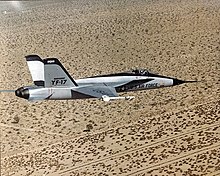

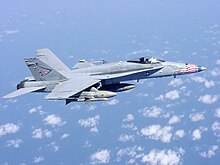



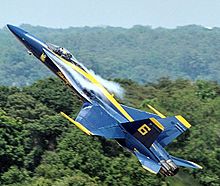



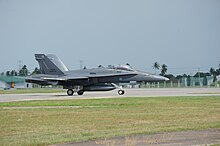



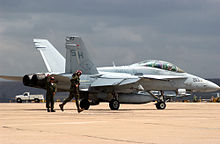
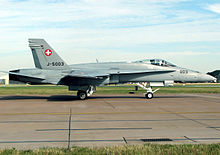
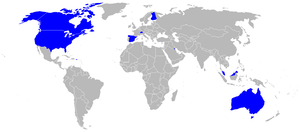
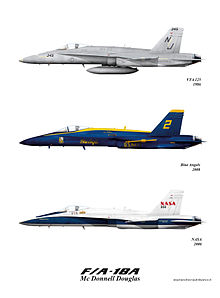



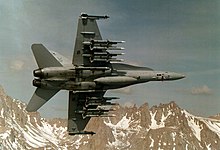

No comments:
Post a Comment